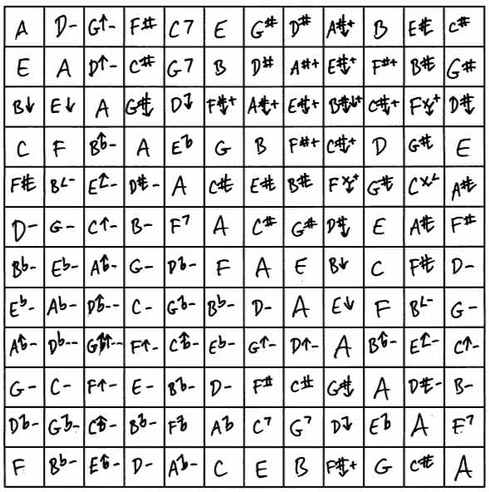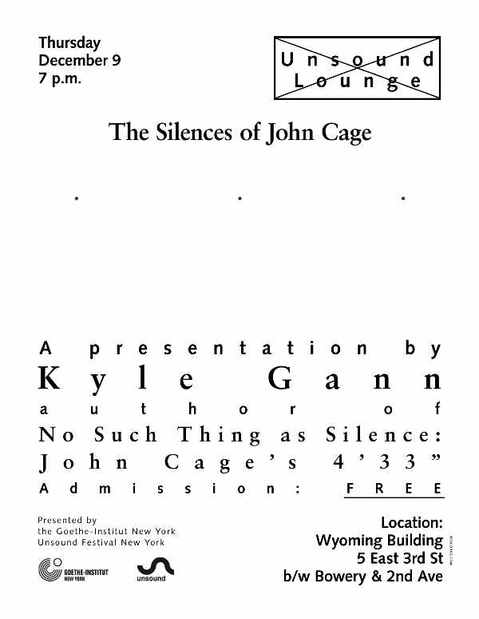main: December 2010 Archives
I've finally gotten around to buying and reading Howard Pollack's book on John Alden Carpenter, which I'd fondled in bookstores for years. It's a succinct, engaging, curiosity-satisfying piece of scholarship. Curiously heavy on the critical reception of Carpenter - so much so, in fact, that he spends considerable space on a 1986 review I wrote for Fanfare magazine of Carpenter's piano music. Carpenter is a composer whose tragedy was to watch his reputation soar and then to plummet in later life, to the point of becoming almost a figure of fun to younger composers.
Yet Carpenter remains a famous name. When I was young, he was one of the first "modern" composers I heard of. And what pieces did I read about? Skyscrapers and Krazy Kat. Why? Because Carpenter lived in Chicago in the jazzy 1920s. He was part of the age of skyscrapers and newspaper comics and heavy machinery, and his music betokened the point at which exploding urbanization still seemed sexy. Skyscrapers and Krazy Kat fit his narrative. He also wrote a tone poem called Sea Drift that Pollack and others consider a better piece. But Sea Drift? Number one, Chicago is a long way from any sea. Two, that's a Walt Whitman reference, and Whitman was an East-Coaster, and besides, Sea Drift is Vaughan Williams and Delius territory, part of the maudlin British transatlantic experience, not material for the jazzy and urbane Carpenter, wealthy heir to a manufacturing fortune. Sea Drift may be a better-written piece than Krazy Kat (not so I'm convinced of that, actually), but it had never entered my consciousness, even though I've had the Abany Symphony recording since it was on vinyl. It didn't fit my narrative of Carpenter. The fact that he wrote a sentimental tone poem on Whitman is a cognitive dissonance with my image of him, magnum opus notwithstanding.
(For the record, and before I get to my main point, going deeper into Carpenters's music has convinced me that he is rather woefully underrecognized. He never should have written that damn Perambulator piece, it trivialized his reputation. It's true that even his symphonies have a kind of unfocused, balletic quality that sounds like film music today, but the music is always graceful and "debonair" - to repeat the aptest term it habitually elicited. And fairly often, as particularly in his 1927 String Quartet, it achieves an enchanting vigor and rhythmic surprise. Look up that string quartet, it's a forgotten classic.)
To be absorbed into the public dialogue requires a narrative. To not project a narrative is to have no career at all. Only a few dozen musicians, or if you're lucky a few hundred, will ever take a close enough look to see what you've actually accomplished. The rest of the musical public will inevitably receive a caricature of you, because that's all they have time or attention or insight for. That's the veil of Maya, of illusion, the conventional wisdom that we can look down our nose at but whose influence we can never escape. The public can take in Carpenter = Krazy Kat because it makes sense, but Krazy Kat plus Sea Drift is too complex, too nuanced, for even the peripheral imagination of a scholar like myself, and only now have I gotten around to more than a peripheral look. I ignored Sea Drift as an almost painful reality, because it took some effort to factor into the image of a composer I didn't yet have the incentive to focus on.
Common sense and self-interest would dictate that composers would play to their narrative, but most of us shrink from it in disdain. Take me. I've made a big deal about microtonality, and I find myself almost universally described as a microtonal composer, even though some 2/3 to 3/4 of my output so far is in the good old 12-tone scale. Custer and Sitting Bull is probably my best-known piece, or the piece with which I'm most associated. And for good reason - it combines microtonality with my Texas roots and my interest in American Indian music. It fuses well with my bull-in-a-china-shop personality, my 6'2" stature, and my southern accent. Were I a short, Jewish New Yorker, this piece would never have gotten off the ground. Had I been attentive to my narrative, I would have followed it up with, say, a microtonal opera about Jesse James, or a song cycle on the letters of Calamity Jane (which Ben Johnston actually beat me to). I could have become the "microtonal wild-west-history composer." Instead, I wrote a chamber quartet called Kierkegaard, Walking, with 12 pitches to the octave. I think it's one of my best works. But what was I, a Texan transplanted to New York, doing having a fascination with Kierkegaard? How much of my life has taken place in Denmark? Four days. Kierkegaard, Walking may be my Sea Drift, a piece so incongruent with my image, my narrative, that no one wants to notice it. In fact, my personal image includes an affection for 19th-century writers, including Emerson, Kierkegaard, Thoreau, Jones Very, and even Custer (as memoirist) and Sitting Bull (as orator). But that's both a little complex for a narrative and not terribly distinctive in terms of distinguishing me from other composers.
We can all name a few composers who do seem to assiduously sculpt their narrative. I recently had a chance to examine the scores of Steve Reich's Sextet and Double Sextet, and nearly slapped my forehead when I saw how similar, how identical in notation and gesture, they are to Six Pianos, Music for 18 Musicians, and all those much older other pieces. I had the presumably common thought that I could write my own Steve Reich piece at this point, and hardly needed Reich to do it for me. He's been unbendingly faithful to his brand. He sells a ton of records because he's predictable - or the kinder word would be reliable.
The vast majority of us, I think, resist this. We don't want to be "pigeonholed" (an overused word, and what does it mean?). We want to show off our range, our versatility. I wrote once that Bill Duckworth was the Schumann-like modern master of multi-movement form, and his next piece was Blue Rhythm, in one extended movement. I noticed publicly that Joan Tower uses the motive of a minor third expanding to a major third in virtually every piece, and in her next work, the Third Quartet, that figure was conspicuously absent. Most of us are embarrassed at being caught repeating ourselves, even in our virtues. We want to prove we can master both collages and drone pieces, adagios and scherzos, tonality and atonality. Or else we simply get bored replicating earlier achievements, and having done one kind of thing well, now want to succeed at another. Or we fancy ourselves above the usual forces of history, fancy that the inherent power of our art will break through the veil of illusion and move listeners in no matter what genre, in pursuit of no matter what subject matter. This might have been more likely 200 years ago when the competition was less voluminous. Yet even so, there are Beethoven works, like his early choral music and those Irish folk songs he was so painfully proud of, that we can't bear to look in the face. Even Beethoven has his Sea Drifts.
To so reflexively resist the call of the narrative seems, actually, counter-productive in a career sense, almost self-destructive. Poor Carpenter, had he not wanted to slide out of the scene, should doubtless have followed up Krazy Kat and Skyscrapers with a Machine Symphony, a ballet called Streetcar, a tone poem about Wall Street. Having cornered a certain market, he should have churned out more of what the public believed he could do best. Instead, he wanted to prove his soulful, Brahmsian earnestness with a respectable Piano Quintet and a Violin Concerto (which, amazingly, seems never to have been recorded, and Pollack makes it sound intriguing). As a result he slid into semi-oblivion. We composers, we are all John Alden Carpenters, and, however much prized by specialists, will enter public consciousness only, if at all, through the narrow tunnel of the available narratives, which are only partly susceptible to our own shaping. And so, with the loftiest intentions, we embrace obscurity rather than be so confined and only incompletely understood. It's peculiar.
And with that thought, merry Christmas.
 I had a notice from the post office of a package waiting for me, so I stopped to pick it up on the way to school. It was a CD set. I get a lot of those sent to me. This one was Minimal Piano Collection Volume X-XX, a bunch of minimalist pieces for multiple pianos put together by Dutch pianist Jeroen van Veen on the Brilliant Classics label. I had seen the first Volume (I-IX because it contains nine CDs) in Amsterdam, but hadn't bought it because I already had other recordings of some of the music. So I was glad to get this, and didn't think too much about it as I was rushing to school - until I turned it over and noticed my own name. And sure enough, Jeroen and Sandra van Veen (with overdubbing) included my Long Night (1981) for three pianos, and I had no idea they were doing it. As I look through my old e-mails, I find that Jeroen did write long ago to express general interest, but I don't believe he ever told me it was coming out. The other composers in the collection are (take a deep breath) John Adams, Jurriaan Andriessen, Louis Andriessen, Marcel Bergmann, William Duckworth (Forty Changes and Binary Images, which I didn't know and they're lovely), Julius Eastman (Gay Guerilla), Douwe Eisenga, Morton Feldman (including the seminal Piece for Four Pianos, which I'd only had on scratchy vinyl), Graham Fitkin, Joep Franssens, Philip Glass, Gabriel Jackson, Tom Johnson, Simeon ten Holt, David Lang (Orpheus Over and Under), Colin McPhee, Chiel Meijering, Wim Mertens, John Metcalf, Carlos Michans, Meredith Monk, Arvo Pärt, Michael Parsons, Alexander Rabinovitch, Steve Reich, Frederic Rzewski, Tim Seddon, Jeroen van Veen, Jacob er Veldhuis, and Kevin Volans (Cicada, great piece).
I had a notice from the post office of a package waiting for me, so I stopped to pick it up on the way to school. It was a CD set. I get a lot of those sent to me. This one was Minimal Piano Collection Volume X-XX, a bunch of minimalist pieces for multiple pianos put together by Dutch pianist Jeroen van Veen on the Brilliant Classics label. I had seen the first Volume (I-IX because it contains nine CDs) in Amsterdam, but hadn't bought it because I already had other recordings of some of the music. So I was glad to get this, and didn't think too much about it as I was rushing to school - until I turned it over and noticed my own name. And sure enough, Jeroen and Sandra van Veen (with overdubbing) included my Long Night (1981) for three pianos, and I had no idea they were doing it. As I look through my old e-mails, I find that Jeroen did write long ago to express general interest, but I don't believe he ever told me it was coming out. The other composers in the collection are (take a deep breath) John Adams, Jurriaan Andriessen, Louis Andriessen, Marcel Bergmann, William Duckworth (Forty Changes and Binary Images, which I didn't know and they're lovely), Julius Eastman (Gay Guerilla), Douwe Eisenga, Morton Feldman (including the seminal Piece for Four Pianos, which I'd only had on scratchy vinyl), Graham Fitkin, Joep Franssens, Philip Glass, Gabriel Jackson, Tom Johnson, Simeon ten Holt, David Lang (Orpheus Over and Under), Colin McPhee, Chiel Meijering, Wim Mertens, John Metcalf, Carlos Michans, Meredith Monk, Arvo Pärt, Michael Parsons, Alexander Rabinovitch, Steve Reich, Frederic Rzewski, Tim Seddon, Jeroen van Veen, Jacob er Veldhuis, and Kevin Volans (Cicada, great piece). Sites To See
AJ Blogs
AJBlogCentral | rssculture
Terry Teachout on the arts in New York City
Andrew Taylor on the business of arts & culture
rock culture approximately
Laura Collins-Hughes on arts, culture and coverage
Richard Kessler on arts education
Douglas McLennan's blog
Dalouge Smith advocates for the Arts
Art from the American Outback
Chloe Veltman on how culture will save the world
For immediate release: the arts are marketable
No genre is the new genre
David Jays on theatre and dance
Paul Levy measures the Angles
Judith H. Dobrzynski on Culture
John Rockwell on the arts
innovations and impediments in not-for-profit arts
Jan Herman - arts, media & culture with 'tude
dance
Apollinaire Scherr talks about dance
Tobi Tobias on dance et al...
jazz
Howard Mandel's freelance Urban Improvisation
Focus on New Orleans. Jazz and Other Sounds
Doug Ramsey on Jazz and other matters...
media
Jeff Weinstein's Cultural Mixology
Martha Bayles on Film...
classical music
Fresh ideas on building arts communities
Greg Sandow performs a book-in-progress
Harvey Sachs on music, and various digressions
Bruce Brubaker on all things Piano
Kyle Gann on music after the fact
Greg Sandow on the future of Classical Music
Norman Lebrecht on Shifting Sound Worlds
Joe Horowitz on music
publishing
Jerome Weeks on Books
Scott McLemee on books, ideas & trash-culture ephemera
theatre
Wendy Rosenfield: covering drama, onstage and off
visual
Public Art, Public Space
Regina Hackett takes her Art To Go
John Perreault's art diary
Lee Rosenbaum's Cultural Commentary



